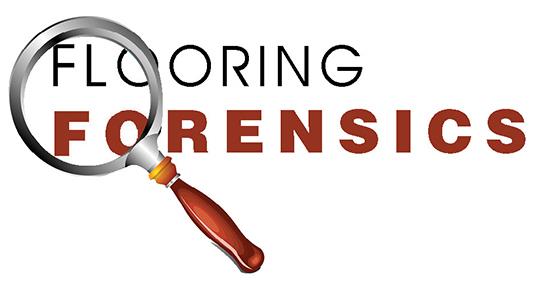Flooring Forensics: Is PVC-free all it’s cracked up to be? - Feb 2020
By Lew Migliore
What is PVC-free resilient flooring, and is it truly the best choice for the health of those living atop it as well as the one least disruptive to the environment?
Most vinyl flooring contains plasticizers in order to confer flexibility, and traditionally those plasticizers have been made from petroleum-based phthalates, though in recent years most suppliers to the U.S. market have come up with alternatives because phthalates migrate from vinyl and have been determined to be carcinogenic and otherwise unhealthy. U.S. vinyl producers have all developed alternatives. However, most vinyl flooring is imported from China, and it can be hard to determine whether all these imports are phthalate free.
PVC-free flooring does not contain phthalates, and therefore eliminates the concerns associated with them. This is obviously a good thing. So is PVC-free then the superior choice? The fact is that the issue is more complex than it may first seem.
THE FACTS
As the largest single material used in the built environment, plastic surrounds us. It’s in everything: from lining the inside of our cars to carrying the water we drink to, well, look around-plastic is in almost everything, even the credit cards in our pockets. To isolate plasticizer migration from flooring as a major concern is, then, to be somewhat naïve. It is my opinion, then, that considering the sea of plastic within which we dwell, PVC in flooring is not going to compromise the health of occupants in a space in which it’s installed, unless there is a concern for a legitimate plasticizer migration event from a flooring material that is leaching.
Across the entire luxury vinyl tile and plank market, development is moving at light speed. PVC-free flooring is in the early stages of development, and there are challenges in working with these alternative materials. Alternative materials to phthalated vinyl include: virgin PET; PET from recycled plastic bottles; polyolefin and polypropylene materials; acrylic polymers; ethylene-vinyl acetate; and polyurethane made from soy-based resins. Each of these PVC-free thermoplastics creates its own set of performance circumstances. These can be the same as with typical vinyl flooring, or they can be unique. For instance, while some will have the ability to stick to the floor with commonly used adhesives, polypropylene is a challenge in this regard, as it is inherently hydrophobic, which means it repels water, and most flooring adhesives are water-based.
GREEN OR GREENWASH?
To improve materials while also adhering to the ideals of creating a truly green flooring chemistry, developers must design for degradation, design benign or less toxic compounds, and prevent the production of waste. Also, they should consider using renewable feedstocks and benign solvents as well as improving performance of the flooring material, yielding a longer lifecycle.
Bio-based PVC-free flooring ingredients are from plants, renewable resources or outside the common chemical stream of conventional chemicals currently used for vinyl flooring, which originate from petroleum. However, there are no guarantees that being bio-based makes them inherently safer or more environmentally friendly than nonrenewable conventional PVC flooring.
PVC-free flooring can be made from a number of different processes that include the use of vegetable oils, cellulose, starches, acids and alcohols-there are hundreds of them. Contrary to what many believe, bioplastics and PVC-free materials are not necessarily completely green, and the characteristics of the finished flooring material can be different depending on how they’re made. This can lead to performance challenges similar to what we see with standard vinyl flooring. The fact is, “green” plasticizers can still leach from the flooring material, and the flooring can still undergo dimensional or planar issues.
In two very recent cases of PVC-free flooring failures, LGM Associates has found stability issues. In one case, the manufacturer brought in an expert to evaluate the problem. Every conceivable type of mitigation was tried and said to be the answer to the problem. When all was said and done, the product did exactly what it had done originally, despite every effort to prove otherwise. The problem was the product.
In another case, the flooring was lifting and cupping. It was also shrinking on the ends. In addition, the flooring emitted an odor of phthalate plasticizer or alcohol, when it was lifted off the substrate-phthalate plasticizer that was not supposed to be there, and the product was labeled as PVC-free.
Just remember, the hype about PVC-free flooring has to be taken with a grain of salt, just like the hype about waterproof flooring. It’s possible that these new products will have some inherent characteristics that could compromise their performance, and frequently the installation firm gets blamed when this occurs, though often it’s the product that’s the problem.
WHAT’S REALLY INSIDE?
How is a consumer to know whether the product is actually what it is said to be? How can they know if something that they can’t see is or isn’t really there without sophisticated laboratory testing? After all, LGM Associates often tests to see whether wearlayers are what they’re supposed to be and frequently find them to be off. Why would content be any different?
The flooring industry trusts that the hard surface flooring product in the box is what it is said to be, but the majority of vinyl flooring products-well over 80% of PVC-based and over 90% of PVC-free-are sourced. The company that is selling it did not make it, and, to compound the problem, the people on the retail floor selling the products often have little knowledge of what they are actually peddling. Never in the history of the industry has any product category upset the balance of traditional flooring like luxury tile and plank. As the category continues to evolve, the entire industry is on the learning curve. Hang on, because this ride is going to get wilder.
Copyright 2020 Floor Focus
